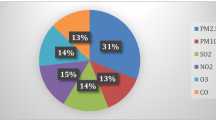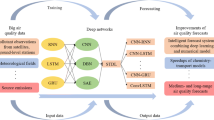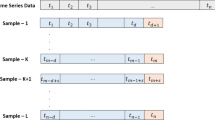Abstract
With the rapid development of urbanization and industrialization, many developing countries are suffering from heavy air pollution. Governments and citizens have expressed increasing concern regarding air pollution because it affects human health and sustainable development worldwide. Current air quality prediction methods mainly use shallow models; however, these methods produce unsatisfactory results, which inspired us to investigate methods of predicting air quality based on deep architecture models. In this paper, a novel spatiotemporal deep learning (STDL)-based air quality prediction method that inherently considers spatial and temporal correlations is proposed. A stacked autoencoder (SAE) model is used to extract inherent air quality features, and it is trained in a greedy layer-wise manner. Compared with traditional time series prediction models, our model can predict the air quality of all stations simultaneously and shows the temporal stability in all seasons. Moreover, a comparison with the spatiotemporal artificial neural network (STANN), auto regression moving average (ARMA), and support vector regression (SVR) models demonstrates that the proposed method of performing air quality predictions has a superior performance.






Similar content being viewed by others
References
Baklanov A, Mestayer PG, Clappier A, Zilitinkevich S, Joffre S, Mahura A, Nielsen NW (2008) Towards improving the simulation of meteorological fields in urban areas through updated/advanced surface fluxes description. Atmos Chem Phys 8:523–543. doi:10.5194/acp-8-523-2008
Barnard E (1992) Optimization for training neural nets. IEEE Trans Neural Netw 3:232–240. doi:10.1109/72.125864
Bengio Y (2009) Learning deep architectures for AI. Found Trends Mach Learn 2:1–127
Bengio Y, Lamblin P, Popovici D, Larochelle H (2007) Greedy layer-wise training of deep networks. Adv Neural Inf Proces Syst 19:153
Boureau Y, Cun YL (2008) Sparse feature learning for deep belief networks. In: Platt JC, Koller D, Singer Y, Roweis ST (eds) Advances in Neural Information Processing Systems 20, Proceedings of Neural Information Processing Systems (NIPS 2007)
Box GEP, Jenkins GM (1970) Time series analysis, forecasting, and control. Holden-Day, San Francisco
Bravo MA, Bell ML (2011) Spatial heterogeneity of PM10 and O3 in São Paulo, Brazil, and implications for human health studies. J Air Waste Manage Assoc 61:69–77. doi:10.3155/1047-3289.61.1.69
Bruckman L (1993) Overview of the enhanced geocoded emissions modeling and projection (enhanced GEMAP) system. In: Proceedings of the Air & Waste Management Association’s regional photochemical measurements and modeling studies conference, San Diego, CA
Chan TH, Jia K, Gao S, Lu J, Zeng Z, Ma Y (2015) PCANet: a simple deep learning baseline for image classification? IEEE Trans Image Process 24:5017–5032. doi:10.1109/TIP.2015.2475625
Chen Y, Shi R, Shu S, Gao W (2013) Ensemble and enhanced PM10 concentration forecast model based on stepwise regression and wavelet analysis. Atmos Environ 74:346–359. doi:10.1016/j.atmosenv.2013.04.002
Chen J, Lu J, Avise JC, DaMassa JA, Kleeman MJ, Kaduwela AP (2014) Seasonal modeling of PM 2.5 in California’s San Joaquin valley. Atmos Environ 92:182–190. doi:10.1016/j.atmosenv.2014.04.030
Cheng T, Wang J, Li X (2007) The support vector machine for nonlinear spatio-temporal regression. Proc Geocomputation 2007
Coats Jr CJ (1996) High-performance algorithms in the sparse matrix operator kernel emissions (SMOKE) modeling system. In: Proc. Ninth AMS Joint Conference on Applications of Air Pollution Meteorology with A&WMA, Amer. Meteor. Soc., Atlanta, GA
Collobert R, Weston J (2008) A unified architecture for natural language processing: deep neural networks with multitask learning. In: Proceedings of the 25th International Conference on Machine Learning. ACM, New York, pp 160–167
Díaz-Robles LA, Ortega JC, Fu JS, Reed GD, Chow JC, Watson JG, Moncada-Herrera JA (2008) A hybrid ARIMA and artificial neural networks model to forecast particulate matter in urban areas: the case of Temuco, Chile. Atmos Environ 42:8331–8340. doi:10.1016/j.atmosenv.2008.07.020
Gardner MW, Dorling SR (1998) Artificial neural networks (the multilayer perceptron)—a review of applications in the atmospheric sciences. Atmos Environ 32:2627–2636. doi:10.1016/S1352-2310(97)00447-0
Goyal P, Chan AT, Jaiswal N (2006) Statistical models for the prediction of respirable suspended particulate matter in urban cities. Atmos Environ 40:2068–2077. doi:10.1016/j.atmosenv.2005.11.041
Guocai Z (2004) Progress of weather research and forecast (WRF) model and application in the United States. Meteorol Mon 12:5
Hájek P, Olej V (2012) Ozone prediction on the basis of neural networks, support vector regression and methods with uncertainty. Ecol Inform 12:31–42. doi:10.1016/j.ecoinf.2012.09.001
Hanson SJ, Giles CL (1993) Proceedings, advances in neural information processing systems 5. Morgan Kaufmann Publishers, San Francisco
Hinton GE, Salakhutdinov RR (2006) Reducing the dimensionality of data with neural networks. Science 313:504–507. doi:10.1126/science.1127647
Hinton GE, Osindero S, Teh YW, Fast A (2006) A fast learning algorithm for deep belief nets. Neural Comput 18:1527–1554. doi:10.1162/neco.2006.18.7.1527
Hooyberghs J, Mensink C, Dumont G, Fierens F, Brasseur O (2005) A neural network forecast for daily average PM concentrations in Belgium. Atmos Environ 39:3279–3289. doi:10.1016/j.atmosenv.2005.01.050
Huang W, Song G, Hong H, Xie K (2014) Deep architecture for traffic flow prediction: deep belief networks with multitask learning. IEEE Trans Intell Transp Syst 15:2191–2201. doi:10.1109/TITS.2014.2311123
Jeong JI, Park RJ, Woo J, Han Y, Yi S (2011) Source contributions to carbonaceous aerosol concentrations in Korea. Atmos Environ 45:1116–1125. doi:10.1016/j.atmosenv.2010.11.031
Jerrett M, Burnett RT, Ma R, Pope CA, Krewski D, Newbold KB, Thurston G, Shi Y, Finkelstein N, Calle EE, Thun MJ (2005) Spatial analysis of air pollution and mortality in Los Angeles. Epidemiology 16:727–736. doi:10.1097/01.ede.0000181630.15826.7d
Kambhatla N, Leen TK (1997) Dimension reduction by local principal component analysis. Neural Comput 9:1493–1516. doi:10.1162/neco.1997.9.7.1493
Kim Y, Fu JS, Miller TL (2010) Improving ozone modeling in complex terrain at a fine grid resolution: part I–examination of analysis nudging and all PBL schemes associated with LSMs in meteorological model. Atmos Environ 44:523–532. doi:10.1016/j.atmosenv.2009.10.045
Kracht O, Parravicini F, Gerboles M (2015) Temporal trends of spatial correlation within the PM10 time series of the AirBase ambient air quality database. Int J Environ Pollut 58:63–78
Künzli N, Kaiser R, Medina S, Studnicka M, Chanel O, Filliger P, Herry M, Horak F, Puybonnieux-Texier V, Quénel P, Schneider J, Seethaler R, Vergnaud JC, Sommer H (2000) Public-health impact of outdoor and traffic-related air pollution: a European assessment. Lancet 356:795–801. doi:10.1016/S0140-6736(00)02653-2
Kurt A, Oktay AB (2010) Forecasting air pollutant indicator levels with geographic models 3 days in advance using neural networks. Expert Syst Appl 37:7986–7992. doi:10.1016/j.eswa.2010.05.093
Lal B, Tripathy SS (2012) Prediction of dust concentration in open cast coal mine using artificial neural network. Atmos Pollut Res 3:211–218
Legendre P (1993) Spatial autocorrelation: trouble or new paradigm? Ecol 74:1659–1673. doi:10.2307/1939924
Li C, Hsu NC, Tsay S (2011) A study on the potential applications of satellite data in air quality monitoring and forecasting. Atmos Environ 45:3663–3675. doi:10.1016/j.atmosenv.2011.04.032
Lv Y, Duan Y, Kang W, Li Z, Wang F (2015) Traffic flow prediction with big data: a deep learning approach. IEEE Trans Intell Transport Syst:1–9. doi:10.1109/TITS.2014.2345663
Martin RL, Oeppen JE (1975) The identification of regional forecasting models using space: time correlation functions. Transactions Inst Br Geographers:95–118. doi:10.2307/621623
Mohamed AR, Sainath TN, Dahl G, Ramabhadran B, Hinton GE, Picheny MA (2011) Deep belief networks using discriminative features for phone recognition. In: 2011 I.E. International Conference on Acoustics, Speech and Signal Processing (ICASSP).
Nguyen VA, Starzyk JA, Goh WB, Jachyra D (2012) Neural network structure for spatio-temporal long-term memory. IEEE Trans Neural Netw Learn Syst 23:971–983. doi:10.1109/TNNLS.2012.2191419
Nieto PG, Combarro EF, Del Coz Díaz JJ, Montañés E (2013) A SVM-based regression model to study the air quality at local scale in Oviedo urban area (Northern Spain): a case study. Appl Math Comput 219:8923–8937. doi:10.1016/j.amc.2013.03.018
Poultney C, Chopra S, Cun YL (2006) Efficient learning of sparse representations with an energy-based model. In: Schölkopf B, Platt J, THofmann T (eds) Advances in neural information processing systems 19, proceedings of the 2006 conference. MIT Press, Cambridge, MA, pp. 1137–1144
Prybutok VR, Yi J, Mitchell D (2000) Comparison of neural network models with ARIMA and regression models for prediction of Houston’s daily maximum ozone concentrations. Eur J Oper Res 122:31–40. doi:10.1016/S0377-2217(99)00069-7
Saide PE, Carmichael GR, Spak SN, Gallardo L, Osses AE, Mena-Carrasco MA, Pagowski M (2011) Forecasting urban PM10 and PM2. 5 pollution episodes in very stable nocturnal conditions and complex terrain using WRF–Chem CO tracer model. Atmos Environ 45:2769–2780. doi:10.1016/j.atmosenv.2011.02.001
Sánchez AB, Ordóñez C, Lasheras FS, de Cos Juez FJ, Roca-Pardiñas J (2013) Forecasting SO2 pollution incidents by means of Elman artificial neural networks and ARIMA models. Abstr Appl Anal 2013:1–6. Hindawi Publishing Corporation. doi:10.1155/2013/238259
Silver D, Huang A, Maddison CJ et al (2016) Mastering the game of Go with deep neural networks and tree search. Nature 529:484–489. doi:10.1038/nature16961
Stern R, Builtjes P, Schaap M, Timmermans R, Vautard R, Hodzic A, Memmesheimer M, Feldmann H, Renner E, Wolke R (2008) A model inter-comparison study focussing on episodes with elevated PM10 concentrations. Atmos Environ 42:4567–4588. doi:10.1016/j.atmosenv.2008.01.068
Suárez Sánchez A, García Nieto PJ, Iglesias-Rodríguez FJ, Vilan Vilan JA (2013) Nonlinear air quality modeling using support vector machines in Gijón urban area (northern Spain) at local scale. Int J Nonlin Sci Numer Simul 14:291–305
Tenenbaum JB, De Silva V, Langford JC (2000) A global geometric framework for nonlinear dimensionality reduction. Science 290:2319–2323. doi:10.1126/science.290.5500.2319
Vautard R, Builtjes PHJ, Thunis P, Cuvelier C, Bedogni M, Bessagnet B, Honoré C, Moussiopoulos N, Pirovano G, Schaap M (2007) Evaluation and intercomparison of Ozone and PM10 simulations by several chemistry transport models over four European cities within the CityDelta project. Atmos Environ 41:173–188. doi:10.1016/j.atmosenv.2006.07.039
Vincent P, Larochelle H, Bengio Y, Manzagol PA (2008) Extracting and composing robust features with denoising autoencoders. In: Proceedings of the 25th International Conference on Machine Learning
Vincent P, Larochelle H, Lajoie I, Bengio Y, Manzagol PA (2010) Stacked denoising autoencoders: learning useful representations in a deep network with a local denoising criterion. J Mach Learn Res 11:3371–3408
Wang Q, Lin J, Yuan Y (2016) Salient band selection for hyperspectral image classification via manifold ranking. IEEE Trans Neural Netw Learn Syst 27:279–1289
Zhang CY, Chen CLP, Gan M et al (2015) Predictive deep Boltzmann machine for multiperiod wind speed forecasting. IEEE Trans Sustain Energy 6:1416–1425
Zheng Y, Liu F, Hsieh H (2013) U-Air: when urban air quality inference meets big data. In: Proceedings of the 19th ACM SIGKDD International Conference on Knowledge Discovery and Data Mining. ACM, New York, pp 1436–1444
Acknowledgments
This research was sponsored by the National Science-technology Support Plan Project of China (Grant Nos. 2015BAJ02B00 and 2015BAJ02B03).
Author information
Authors and Affiliations
Corresponding author
Additional information
Responsible editor: Marcus Schulz
Rights and permissions
About this article
Cite this article
Li, X., Peng, L., Hu, Y. et al. Deep learning architecture for air quality predictions. Environ Sci Pollut Res 23, 22408–22417 (2016). https://doi.org/10.1007/s11356-016-7812-9
Received:
Accepted:
Published:
Issue Date:
DOI: https://doi.org/10.1007/s11356-016-7812-9




